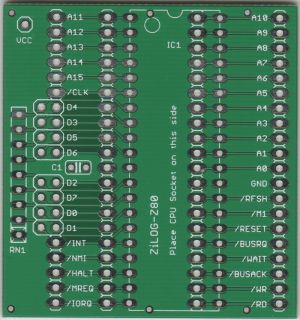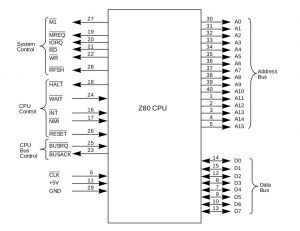Lo-tech Z80 CPU Test Adapter
The Lo-tech Z80 CPU Test Adapter is a simple board designed to assist with troubleshooting of Z80 based systems by enabling easy measurement of all CPU signals, and the option to present known wave-forms on all of the address bus CPU outputs.
Documentation has been developed with the kind assistance of Larry Kraemer.
Note: this board has been discontinued.
Usage
The board provides a DIP-40 socket that should be populated with a known-good Z80 CPU. The target system CPU should then be removed, and replaced with the board. CPU orientation should be set the same as the system board.
Test probes (for logical analyser, oscilliscope, or simple multimeter) can be connected to the labelled pins to observe signals during system operation.
With the eight 2-pin headers D0 to D7 open, the mounted CPU will be isolated from the data bus and those signals held low via RN1, interpreted as NOOP instruction. Therefore the CPU will increment the program counter, and repeat - resulting in the processor attempting memory read on all of the 64KB address space continuously. The address bus signals can therefore be monitored for expected operation (square wave, with A1 having a period half that of A0, and A2 half that of A1 etc). Other signals (clock, refresh, read, mreq) can also be observed for proper operation.
With the eight 2-pin headers D0 to D7 closed, the CPU will be engaged with the data bus, and therefore normal operation should resume (once problems have been rectified!).
Construction
First mount the two 20-pin headers that will be inserted into the system board CPU socket, soldering on the top side of the board (with signal names listed). In order to properly align the pins, it may be helpful to insert the headers into the un-mounted DIP socket to hold them straight. Next mount the CPU socket and remaining components, soldering on the underside.
Testing Procedure
- Remove the Z80 CPU from the motherboard to be tested, and set it aside.
- Install the Lo-tech Z80 CPU Test Adapter (with a known good Z80) in the motherboard to be tested. Ensure the notch faces in the same direction as the original Z80 CPU.
- Apply power to the motherboard.
- Inspect the address lines for the wave forms listed in the table below.
If pulses are not deteced on the address lines, check the following signals:
| Pin | Signal |
|---|---|
| 11 | +5VDC referenced to Pin 29 (GND) |
| 6 | Phase 0 clock |
| 18 | HALT (should be high) |
| 24 | WAIT (should be high) |
| 26 | RESET (should be high) |
If any of these inputs are held in an incorrect state, the microprocessor will not work. Before continuing, correct any problems with these lines.
CPU Pinout & Expected Wave Forms
| Pin | Name | Wave Form |
|---|---|---|
| 1 | A11 | xx second period square wave |
| 2 | A12 | xx second period square wave |
| 3 | A13 | xx second period square wave |
| 4 | A14 | xx second period square wave |
| 5 | A15 | xx second period square wave |
| 6 | *CLK | |
| 7 | D4 | Tied Low |
| 8 | D3 | Tied Low |
| 9 | D5 | Tied Low |
| 10 | D6 | Tied Low |
| 11 | +5VDC | |
| 12 | D2 | Tied Low |
| 13 | D7 | Tied Low |
| 14 | D0 | Tied Low |
| 15 | D1 | Tied Low |
| 16 | *INT | |
| 17 | *NMI | |
| 18 | *HALT | |
| 19 | *MREQ | |
| 20 | *IORQ | |
| 21 | *RD | |
| 22 | *WR | |
| 23 | *BUSACK | |
| 24 | *WAIT | |
| 25 | *BUSRQ | |
| 26 | *RESET | |
| 27 | *M1 | |
| 28 | *RFSH | |
| 29 | GND | |
| 30 | A0 | xx second period square wave |
| 31 | A1 | xx second period square wave |
| 32 | A2 | xx second period square wave |
| 33 | A3 | xx second period square wave |
| 34 | A4 | xx second period square wave |
| 35 | A5 | xx second period square wave |
| 36 | A6 | xx second period square wave |
| 37 | A7 | xx second period square wave |
| 38 | A8 | xx second period square wave |
| 39 | A9 | xx second period square wave |
| 40 | A10 | xx second period square wave |

